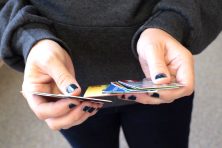Why 28% of Americans Carry Credit Card Debt (and How to Chip Away at It)

As odd as this might sound, credit cards can be among the most frightening tools in a Penny Hoarder’s life.
I once ranked my fear of these flimsy pieces of plastic right up there with roaches and heights.
Yeah, that’s ridiculous, you say. But I’ve read a few too many surveys and studies that expose the dangers of credit cards to your personal finances.
Including this recent one from CreditCards.com that polled 2,005 Americans.
It revealed that a hefty number of us carry an outstanding credit card balance. These outstanding balances lead to a never-ending “credit-card-debt treadmill,” the site describes. (Think: The crazy 15% to 20% interest rates that come with not paying off a card.)
Here are some numbers that served up a jolt of reality:
- Approximately 28% of Americans admitted they don’t pay their credit card bill in full each month.
- Of those, 43% reported they hadn’t fully paid down their credit card in more than two years.
- Nearly 23% folks have been carrying credit card debt for five or more years. In context, that’s nearly 29 million Americans.
When asked why they carry a balance, 32% of the respondents said they simply needed to cover day-to-day expenses; this was the No. 1 reason.
Other reasons included retail purchases, such as clothing or electronics (16%), medical bills (12%), home repairs (10%), vacation expenses (10%) and car repairs (7%).
How to Pay Off Credit Card Debt
This process will differ for everyone, but there are a few basic steps you can take to getting on track.
1. Take a Deep Breath and See What You Owe
This, perhaps, will be your most difficult step — but it needs to be done.
Take stock of your debt. One of the easiest ways to do this is to pull a free credit report, which will outline all of your accounts, including those credit cards with outstanding balances.
For this, I use Credit Sesame. It’s easy and free, and I can check in at any time to take my financial pulse. Plus, it gives me tailored advice on how to clean up my credit report and, in turn, boost my credit score. Learn more about how the service works here.
2. Draw Up a Budget
If you don’t already have a monthly budget, now’s the time to sketch one out. (Here’s a seven-step guide.)
Within that budget, factor in some type of payment plan and how much you want to start paying off each month. No matter how slow and steady the plan is, stick to it.
3. Quit Credit Cards
Yes, there are perks to these suckers (like travel points), but if you’re struggling to manage your money or pay off debt, now isn’t the time to be tempted.
Plus, according to last year’s TD Bank “Merry Money Survey” on holiday spending, consumers end up spending less if they pay with cash.
4. Consider Credit Card Debt Consolidation or Refinancing
If you have credit card debt, you know. The anxiety, the interest rates, the fear you’re never going to escape…
And the truth is, your credit card company doesn’t really care. It’s just getting rich by ripping you off with high interest rates. But a website called AmOne wants to help.
If you owe your credit card companies $50,000 or less, AmOne will match you with a low-interest loan you can use to pay off every single one of your balances.
The benefit? You’ll be left with one bill to pay each month. And because personal loans have lower interest rates (AmOne rates start at 2.49% APR), you’ll get out of debt that much faster. Plus: No credit card payment this month.
AmOne won’t make you stand in line or call your bank, either. And if you’re worried you won’t qualify, it’s free to check online. It takes just two minutes, and it could help you pay off your debt years faster.
Carson Kohler (@CarsonKohler) is a junior writer at The Penny Hoarder. After writing this, she’s considering burning her one credit card.
















